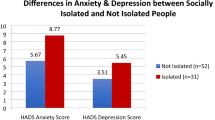Abstract
The influence of social variables on the level of community adjustment of 60 former state hospital patients was examined. Community adjustment was operationalized to include measures of instrumental performance, social participation and satisfaction with community circumstances. Hierarchical regression analysis was utilized to assess the contribution of social-level predictors.
The results of the study suggest that the character of a psychiatric patient's social milieu can influence the success she/he experiences in attempting to adjust to life in the community. Specifically, each of the measures of adjustment was closely related to significant other attitudes, i.e., expectations and tolerance of deviance.
Overall, the results suggest the importance of a social-environmental strategy as a means to achieve positive changes in patients' adjustment to community living.
Similar content being viewed by others
References
Anthony, W., Cohen M., & Vitalo, R. (1978). The measurement of rehabilitation outcome.Schizophrenia Bulletin, 9, 365–387.
Byers, E., & Cohen, S. (1979). Predicting patient outcome: The contribution of prehospital, in-hospital and posthospital factors.Hospital and, Community Psychiatry, 30, 327–331.
Carpenter, J. & Bourestom, N. (1976) Performance of psychiatric hospital discharges in strict and tolerant environments.Community Mental Health Journal, 12, 45–51.
Caton, C. (1981) The new chronic patient and the system of care.Hospital and Community Psychiatry, 32, 475–478.
Coulton, C., Fitch, V. & Holland, T. (1985). A typology of social environments in community care homes.Hospital and Community Psychiatry, 36 373–377.
Freeman, H., & Simmons, O. (1963).The mental patient comes home. New York: Wiley.
Greenley, J. (1979). Family symptom tolerance and rehospitalization experiences of psychiatric patients. In R. Simmons (Ed.),Research in community and mental health. Greenwich, CT: Jai Press.
Hooley, J. (1986). Expressed emotion: A review of the critical literature.Clinical Psychology Review, 5, 119–139.
Hull, J., & Thompson, J. (1981). Factors which contribute to normalization in residential facilities for the mentally ill.Community Mental Health Journal, 71, 107–113.
Kanter, J., Lamb, H. R., & Loeper, C. (1987). Expressed emotion in families: A critical review.Hospital and Community Psychiatry, 38, 374–380.
Kuipers, L. (1979). Expressed emotion: A review.British Journal of Clinical and Social Psychology, 18, 237–243.
Kruzich, T. & Kruzich, S. (1985). Milieu factors influencing patients' integration into community residential facilities.Hospital and Community Psychiatry, 36, 378–382.
Lamb, H. R., & Goertzel, V. (1971). Discharged mental patients — are they really in the community?Archives of General Psychiatry 24, 29–34.
Lamb, H. R., & Goertzel, V. (1972) High expectations of long-term ex-state hospital patients.American Journal of Psychiatry, 124, 471–475.
Leff, J., & Vaughn, C., (1985)Expressed emotion in families. New York: Guilferd Press, Inc.
Liberman, R., & Foy, D. (1983). Psychiatric rehabilitation for chronic mental patients.Psychiatric Annals, 13, 539–545.
Nuehring, E., Thayer, J., & Ladner, R. (1980). On factors predicting rehospitalization among two state mental hospital patient populations.Administration In Mental Health, 7, 247–269.
Pepper, B. (1985). Where (and how) should young adult chronic patients live? the concept of a residential spectrum.The Lines, 2, 1–6.
Rosenblatt, A., & Mayer, J. (1976). The recidivism of mental patients: A review of past studies.American Journal of Orthopsychiatry, 14, 697–706.
Segal, S., & Aviram, U. (1978).The mentally ill in community-based sheltered care: A study of community care and social integration. New York: Wiley-Interscience.
Smith, C. (1978). Recidivism and community adjustment amongst former mental patients.Social Science and Medicine, 12, 17–27.
Strachan, A. (1986). Family intervention for the rehabilitation of schizophrenia: toward protection and coping.Schizophrenia Bulletin, 12, 678–698.
Tessler, R., & Manderscheid, R. (1982). Factors affecting adjustment to community living.Hospital and Community Psychiatry, 33, 203–207.
Vaughn, C., & Leff, J. (1981). Patterns of emotional response in relatives of schizophrenic patients.Schizophrenia Bulletin, 7, 43–44.
Weinman, B., & Kleiner, R. (1978). The impact of community living and community memberintervention on the adjustment of the chronic psychotic patient. In L. Stein & M. Test (Eds.),Alternatuves to mental hospital treatment. New York: Plenum Press.
Author information
Authors and Affiliations
Rights and permissions
About this article
Cite this article
Sommers, I. Tolerance of deviance and the community adjustment of the mentally ill. Community Ment Health J 23, 159–172 (1987). https://doi.org/10.1007/BF00754428
Issue Date:
DOI: https://doi.org/10.1007/BF00754428




